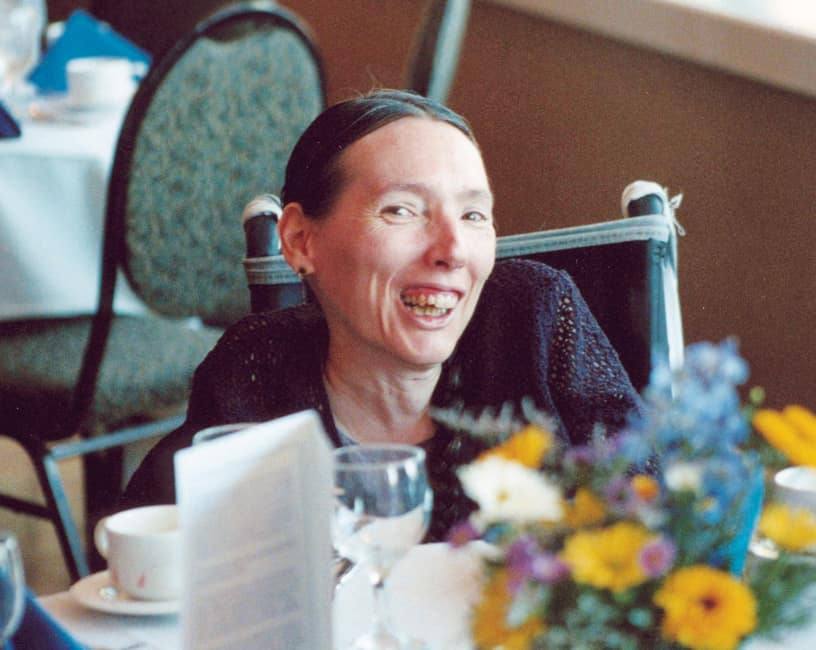
Originally published December 1998
By Harriet McBryde Johnson
 By power chair, I zoom toward the Four Corners of Law, the old heart of Charleston’s legal community. It’s the first day of a federal jury trial, and I’m a lawyer for the plaintiff.
By power chair, I zoom toward the Four Corners of Law, the old heart of Charleston’s legal community. It’s the first day of a federal jury trial, and I’m a lawyer for the plaintiff.
I’m nervous, but I’ve suited up for the occasion. I can’t wear those women-lawyer suits you see on television, but my raw silk turquoise dress drapes nicely around the curves of my back. I’m wearing my best black shoes. They’re velvet, and cost $6 at the local hippie store. And, of course, serious jewelry — a simple gold bracelet, pearl earrings, a sapphire ring. It’s my kind of power dressing. They’ll know I’m a force to be reckoned with.
There’s a lot riding on the opening. Research shows that most jurors are convinced — or not — during opening statements. I’ve heard hints that I’m the wrong person for this job. It’s an ADA case, and my client was fired, she says, because she told her boss she’d need back surgery. The problem is that, compared to me, she doesn’t look like she has a disability. In fact, she looks great in a suit. The company lawyer will surely tell the jury there’s no way this plaintiff can file an ADA lawsuit when there’s nothing wrong with her. How do I convince them otherwise?
I stop obsessing and enjoy the ride. I know every bump in the slate sidewalks, every gap in the old bricks. I know when to slam full speed ahead, when to slow down, when to dodge. As I get closer, I merge with a stream of lawyers and clients striding on legs from downtown offices to court. I flawlessly navigate the challenging terrain without clipping any of them. I’m good. I belong in this world. Nobody can mess with me.
I stop for a line of cars. Beside me an elderly black lady waits at the bus stop and looks me over. I’m used to being gawked at, but this is different. She’s looking at my clothes, my jewelry, my “look,” and her smile is openly appreciative.
I nod at her the way we nod at one another in downtown Charleston.
“You look so beautiful,” she says.
I give her the classic aw-shucks smile.
“You look just like a Doll Baby!”
A Doll Baby? Not a tough, terrifying litigator?
My smile freezes and I say, “Thank you, ma’am.” She means well. And in a flash I know there is a certain Doll Baby factor at work. My body is undeniably small and rag-doll floppy. And, against the vivid turquoise dress, the extreme whiteness of my face and hands must look like — well, porcelain.
The traffic clears and I cross the street. I have one short block to get focused.
I’m jumpy when the judge calls for plaintiff’s opening, but I find the spot where I can meet the eyes of all 12 jurors. As I begin the expected formalities, I find the rituals restore a sense of confidence. Echoed on marble and mahogany, my voice comes back strong, clear, and just genteel enough. I’m ready to confront the issues. I explain about invisible disabilities. I review the evidence. Formality gives way to folksiness. One by one the faces show understanding, acceptance.
As I thank them for their attention, I’m conscious of 12 faces looking at nothing but me. Clearly, they’re responding not only to my words, but also to my visible persona — to the tiny woman in a wheelchair, wearing gorgeous fabrics and precious metals and stones. A different kind of lawyer.
I turn back to the plaintiff’s table and I know those two dozen eyes are watching the arc I make, like a skater, as my tires etch the plush carpeting. For a moment, I wish appearances didn’t matter. I wish I could simply master the law and the evidence and do my job. But then I look back at the jury. They’re still with me, and I’m glad.
The Doll Baby has spoken.
UpdateHarriet McBryde Johnson’s account of her debates with Princeton bioethicist Peter Singer, “Unspeakable Conversations,” caused a sensation in The New York Times Magazine while educating the mainstream public on how life with a disability can be as rewarding and fulfilling as any. She wrote two well-received books before her death in 2008. For 10 years, NM highlighted the work of great women wheelchair users such as Johnson, Nancy Mairs and Gretchen Ryan in an annual Women’s Issue. At a time when men with SCI dominated the landscape, we wanted to connect women with true peers around the topics of body image, domestic abuse, fashion, health, self-esteem and empowerment. (You can find a collection of articles on these topics and more at www.newmobility.com/2011/05/womens-issues.) In 2008, NM editors decided that women’s concerns had been successfully integrated into the publication and that a dedicated Women’s Issue was no longer necessary. Let us know if you agree by emailing jbyzek@unitedspinal.org. |
Support New MobilityWait! Before you wander off to other parts of the internet, please consider supporting New Mobility. For more than three decades, New Mobility has published groundbreaking content for active wheelchair users. We share practical advice from wheelchair users across the country, review life-changing technology and demand equity in healthcare, travel and all facets of life. But none of this is cheap, easy or profitable. Your support helps us give wheelchair users the resources to build a fulfilling life. |


Recent Comments
Kelly DeBardelaben on Tips to Maintain Bowel Regularity with SCI When You Travel
Glen Gregos on Traveling With and Without a Caregiver
Sue on Controller Recall Puts SmartDrive Safety in the Spotlight